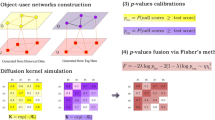Abstract
The tagging system has become the basis of various systems, e.g., geo-social system, marketing system. Understanding the structure among the tags is one of the crucial tasks to the performance of various downstream marketing tasks, such as user behavior understanding, advertising, and recommendation. However, most of the existing methods mainly focus on the association among the tags, which usually results in false intervention suggestions, e.g., recommending a similar item after having bought one. To address this problem, we propose an Iterative Causal Structure Search (ICSS in short) algorithm for the high-dimensional social tags. In each iteration of the proposed approach, we first employ the constraint-based method to discover the skeleton of the causal structure and further employ the additive noise assumption to infer the edges whose directions are unknown in the previous stage. The proposed approach not only benefits from the good scalability of the constraint-based approach but also avoids the Markov equivalence class problem with the help of the additive noise assumption. We also theoretically show the correctness of the proposed algorithm. We test the ICSS and the baselines on both the simulated data and real-world data, further discover some interesting causal structures among the tags in a real-world marketing system.







Similar content being viewed by others
References
Begelman G, Keller P, Smadja F et al (2006) Automated tag clustering: improving search and exploration in the tag space. In: Collaborative web tagging workshop at WWW2006, Edinburgh, Scotland, pp 15–33
Belém FM, Almeida JM, Gonçalves MA (2017) A survey on tag recommendation methods. J Assoc Inf Sci Technol 68(4):830–844
Bischoff K, Firan CS, Nejdl W, Paiu R (2008) Can all tags be used for search? In: Proceedings of the 17th ACM conference on information and knowledge management, pp 193–202
Bonner S, Vasile F (2018) Causal embeddings for recommendation. In: Proceedings of the 12th ACM conference on recommender systems, pp 104–112
Cai R, Qiao J, Zhang K, Zhang Z, Hao Z (2018) Causal discovery from discrete data using hidden compact representation. In: NeurIPS, pp 2666–2674
Cai R, Qiao J, Zhang Z, Hao Z (2018) Self: structural equational likelihood framework for causal discovery. In: Thirty-second AAAI conference on artificial intelligence
Cai R, Zhang Z, Hao Z (2013) Causal gene identification using combinatorial v-structure search. Neural Netw 43:63–71
Cai R, Zhang Z, Hao Z (2013) SADA: a general framework to support robust causation discovery. In: ICML, pp 208–216
Dimitrov D, Helic D, Strohmaier M (2018) Tag-based navigation and visualization. In: Brusilovsky P, He D (eds) Social information access. Springer, Cham, pp 181–212
Hoyer PO, Janzing D, Mooij JM, Peters J, Schölkopf B (2009) Nonlinear causal discovery with additive noise models. In: NIPS, pp 689–696
Hyttinen A, Eberhardt F, Järvisalo M (2014) Constraint-based causal discovery: conflict resolution with answer set programming. In: UAI, pp 340–349
Jabeen F, Khusro S, Majid A, Rauf A (2016) Semantics discovery in social tagging systems: a review. Multimed Tools Appl 75(1):573–605
Mitrovic J, Sejdinovic D, Teh YW (2018) Causal inference via kernel deviance measures. In: Advances in neural information processing systems, pp 6986–6994
Mooij JM, Peters J, Janzing D, Zscheischler J, Schölkopf B (2016) Distinguishing cause from effect using observational data: methods and benchmarks. J Mach Learn Res 17(32):1–102
Hyoryung Nam and Pallassana Krishnan Kannan (2014) The informational value of social tagging networks. J Mark 78(4):21–40
Pearl J, Verma TS (1995) A theory of inferred causation. Stud Logic Found Math 134:789–811
Peters J, Janzing D, Scholkopf B (2011) Causal inference on discrete data using additive noise models. IEEE Trans Pattern Anal Mach Intell 33(12):2436–2450
Peters J, Mooij JM, Janzing D, Schölkopf B et al (2014) Causal discovery with continuous additive noise models. J Mach Learn Res 15(1):2009–2053
Scheines R (1997) An introduction to causal inference. In: Mckim VR, Turner SP (eds) Causality in crisis: statistical methods and the search for causal knowledge in the social science. University of Notre Dame Press, Notre Dame, pp 185–199
Spirtes P, Glymour CN, Scheines R (2000) Causation, prediction, and search. MIT Press, Cambridge
Triantafillou S, Tsamardinos I (2015) Constraint-based causal discovery from multiple interventions over overlapping variable sets. J Mach Learn Res 16(1):2147–2205
Wang Y, Blei DM (2019) The blessings of multiple causes. J Am Stat Assoc 114(528):1574–1596
Xu G, Yu Z, Ping J, Rong P, Wu Z (2015) Kiptc: a kernel information propagation tag clustering algorithm. J Intell Inf Syst 45(1):95–112
Zhang K, Peters J, Janzing D, Schölkopf B (2011) Kernel-based conditional independence test and application in causal discovery. In: UAI, pp 804–813
Zhang K, Hyvärinen A (2009) On the identifiability of the post-nonlinear causal model. In: UAI, pp 647–655
Acknowledgements
This work is supported by the National Natural Science Foundation of China (No.62076073, No. 61703109, No.91748107), the Guangdong Basic and Applied Basic Research Foundation (No. 2020A1515010616), the Guangdong Innovative Research Team Program (No. 2014ZT05G157), the Key-Area Research and Development Program of Guangdong Province (2019B010136001), and the Science and Technology Planning Project of Guangdong Province LZC0023.
Author information
Authors and Affiliations
Corresponding authors
Ethics declarations
Conflict of interest
The authors declare that they have no conflict of interest.
Additional information
Publisher's Note
Springer Nature remains neutral with regard to jurisdictional claims in published maps and institutional affiliations.
Rights and permissions
About this article
Cite this article
Zheng, J., Yang, Z. & Liu, W. Understanding the causal structure among the tags in marketing systems. Neural Comput & Applic 35, 3615–3624 (2023). https://doi.org/10.1007/s00521-020-05552-9
Received:
Accepted:
Published:
Issue Date:
DOI: https://doi.org/10.1007/s00521-020-05552-9




